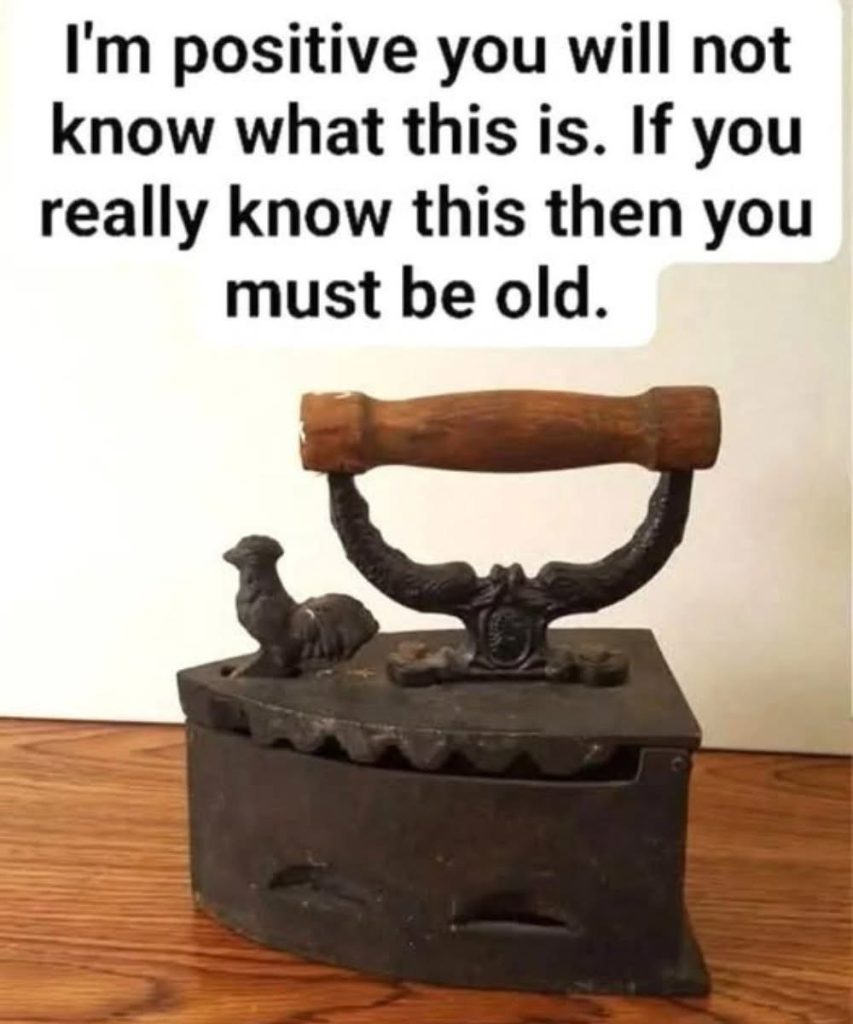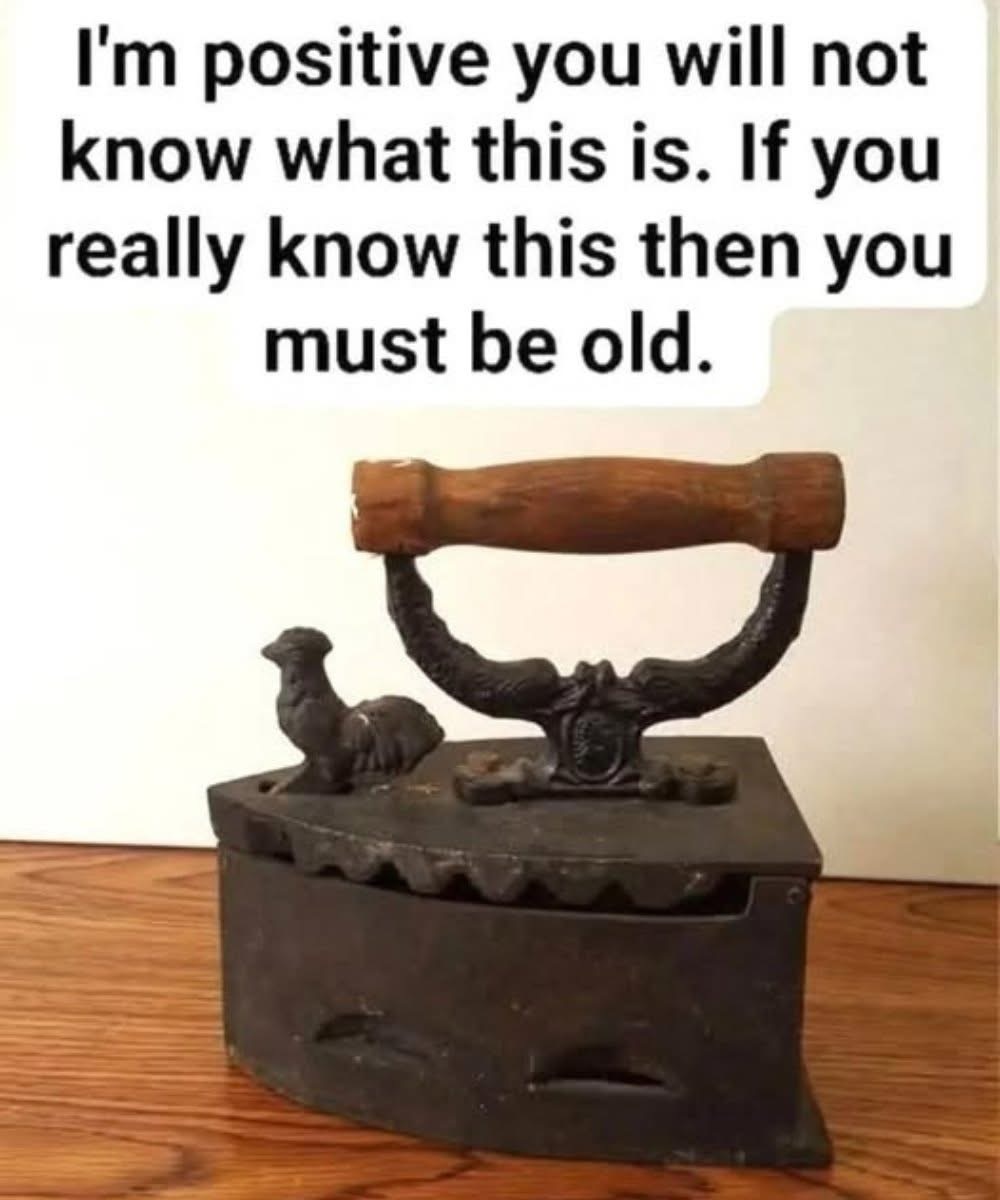
The “mystery” object in the photo: a charcoal box iron
What it is and how it worked
Before electric irons, many homes and professional launderers used charcoal box irons (also called coal irons or charcoal irons). The body is cast iron shaped like a small metal “box” with a hinged lid. Heat didn’t come from a cord—it came from glowing charcoal loaded inside the cavity.
Key features you can spot in the photo:
Wooden handle: Wood doesn’t conduct heat, so you can grip it safely.
Hinged lid and latch/finial: The decorative piece (often a rooster or bird) is actually a latch to open the lid and refill coals.
Air vents: Slots and scalloped edges let air flow so the charcoal keeps burning.
Heavy soleplate: The thick iron base holds and spreads heat evenly across fabric.
How it was used:
A small brazier or stove lit the charcoal.
The hot coals were transferred into the iron’s box.
The lid was latched, and the user tested the heat (often with a scrap of cloth).
As the iron cooled, the user fanned the vents or added fresh coals to maintain temperature.
This design solved a real problem: earlier “sad irons” had to be heated directly on a fire or stove and swapped constantly. With a box iron, the heat source traveled inside the tool, keeping the temperature steadier and ironing faster.
Daily life, craft, and technique
For generations, this was the heart of laundry day. Tailors, dressmakers, hotel laundries, and families relied on it to smooth seams, set pleats, and polish collars.
What made a great press:
Moisture + heat: Clothes were slightly dampened first (sprinkled with water) so steam from the hot soleplate relaxed fibers.
Rhythm: Users learned a rhythm—press, lift, fan the vents to stoke the charcoal, press again.
Starch and finish: Starched cuffs and collars were common; some rubbed a bit of beeswax or soap on the soleplate to glide over fabric.
Care and safety: Ash was emptied outside; coals were handled with tongs; irons were parked on a trivet to protect tables.
Why the decorations?
Makers often added ornamental latches or handles—birds, lions, scrollwork—not just for beauty but for grip and as a quick-acting latch you could lift with one hand. Craftspeople took pride in tools that were both rugged and handsome.
Why it matters today (collecting, caring, and learning from it)
The charcoal iron is more than an antique; it’s a snapshot of ingenuity—a cordless, reusable, repairable appliance long before batteries and chargers.
If you find one:
Check the hinge and latch: They should open/close smoothly and hold the lid tight.
Handle & body: Look for an intact wooden handle and a base that sits flat. Hairline cracks in cast iron can be hard to repair.
Original vs. reproduction: Originals show crisp casting lines, solid weight, and period hardware. Many reproductions look rough inside or use modern screws.
Cleaning & display (safe and simple):
Dust, then use a soft brass brush or fine steel wool to remove loose rust.
Wipe with a little mineral oil or paste wax to seal the surface and bring out the patina.
Display it as a conversation piece; use it as a bookend or doorstop; or pair it with a small card telling its story.
Safety note: Don’t burn charcoal indoors with it—charcoal creates carbon monoxide. If you ever demonstrate it, do so outdoors, with extreme caution.
What it teaches us:
Design with purpose: Every curve and vent exists for airflow, heat, and handling.
Durability: A century later, the tool still works.
Simplicity: It’s fully “off-grid”—no cord, no chip, just heat, mass, and skill.
So if you recognized the object at first glance, you’re not “old”—you’re connected to a rich line of practical know-how. And if you didn’t, now you can point to the rooster latch and say: “That’s a charcoal box iron—heat inside, glide outside, laundry day hero.”
Free Download WordPress ThemesDownload WordPress Themes FreeDownload Premium WordPress Themes FreeDownload Premium WordPress Themes Freeudemy paid course free downloaddownload karbonn firmwareDownload WordPress Themes
